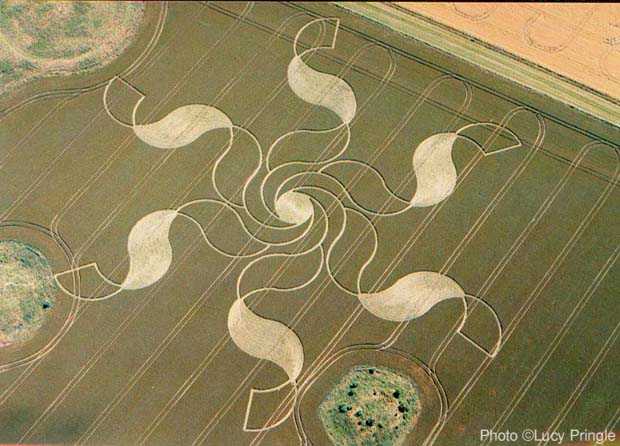The crop circle evolves
Last summer, a 180-metre-long jellyfish surfaced in a barley field in Oxfordshire, UK. How it got there is unclear, but microwave radiation, Global Positioning System receivers and lasers have come under suspicion. This ‘crop circle’ was sculpted from countless stalks that were bent and oriented in ingenious ways.
Bewildering the British since the 1600s, the crop-circle phenomenon has spread to Europe, Russia, North America, Japan and India. The complexity of the designs — many of which have a mathematical basis — has escalated in the past two decades, reflecting a serious and science-literate artistic movement. A bumper crop of patterns is anticipated as the summer kicks off in the Northern Hemisphere.
The first formal scientific comment on crop circles was published in Nature in July 1880 by John Capron, who speculated that the “circular spots” were induced by cyclonic winds (J. R. Capron, Nature 22, 290–291; 1880). A century later, meteorologist Terence Meaden, then at Dalhousie University in Halifax, Canada, refined Capron’s theory to explain more recent crop-circle appearances across southern England. He proposed in 1980 that the airflows induced by local hillsides stabilized the position of whirlwinds long enough to carve the circles.
There was a simpler explanation. Four years earlier, artists Douglas Bower and David Chorley began creating a series of circles in Hampshire’s barley and wheat fields after reading old news reports about a pattern imprinted on Australian marshlands, supposedly by a UFO. Their hopes of initiating a UFO hoax were frustrated by the interest in Meaden’s whirlwind theory. A battle of wits ensued.
Bower and Chorley increased the complexity of their patterns to show that they were not manifestations of the weather. But Meaden adapted his whirlwind theory accordingly: his electromagnetic–hydrodynamic “plasma vortex” explained the multi-circle designs as well as the dead tractor batteries and eerie lights that seemed to accompany their formation. The artists countered by including straight lines in a pictograph consisting of two circles and five rectangles. This convincingly ruled out natural causes, and represented an artistic leap. After ten years of competition, in 1991 the two announced their hoax to the press.
A second wave of crop artists then emerged, cultivating hundreds of increasingly sophisticated pictographs that have appeared annually around the globe. Mathematics is central to the modern designs, which incorporate symbols and fundamental constants such as ? — the ‘golden ratio’ — and ?, sometimes to an accuracy of ten digits. Thanks to increased computing power, iterative equations are used to generate shapes that repeat across many scales. Pictographs today can measure 300 metres across and can comprise up to 2,000 elements.
The designs often integrate Euclidean shapes with fractal icons such as Koch curves and Mandelbrot sets. Over the past five years, such complexity has driven the emerging organic movement, which embeds the mathematical patterns within boundaries that are reminiscent of nature’s forms. This cumulated last year in representations of trilobites, dragonflies, caterpillars, birds and the jellyfish pictured. The seven circles in the jellyfish’s ‘tail’ demonstrate precision scaling and its head displays classic symmetry. The free-form tentacles add the organic quality.
As in all art movements, crop-circle artists follow rules laid down by their founders. Respecting the Bower–Chorley tradition, many create their pictographs anonymously during the short midsummer nights, leaving the scene free of human traces. Their challenge lies in creating the escalating designs within these cultural constraints. Modern construction methods have helped: today’s patterns are mapped out using computers, laser pointers and satellite equipment, and artists work in coordinated teams. Bower once used only a crude sight, consisting of a circular wire dangling from his cap, to guide his lines. Other traditionalists used wooden planks, string and garden rollers. Artists even used bar stools to vault over regions of undisturbed crop. But there are signs that modern techniques are reaching their limits: in 2009, for the first time, one pictograph was created over three nights, potentially compromising the secrecy tenet.
The time-consuming process of imprinting the patterns is slowed by the insistence that crop stalks be flattened rather than broken. Stalk orientation may vary between different parts of one pictograph, and weaving is used to create multiple layers with shadowy textures that change as the stalks move in response to the Sun.
Artists will seek faster methods to maintain the movement’s evolution. Intriguingly, biophysicists who investigated 250 recent pictographs found that the knuckle-like joints of bent stalks were longer than those on untouched stalks from the same field. The observed elongation and swelling of these joints has been replicated using microwaves to superheat the stalks, causing them to fall over. Some patterns may have been sculpted using microwave generators, such as masers or magnetrons from microwave ovens.
The covert nature of the crop-circle movement fuels a cat-and-mouse game between artist and researcher. To appreciate a pictograph’s intricacy, one must take to the air, sometimes photographing a pattern only minutes before it falls under the blades of a harvester. Each season’s designs are published in a catalogue and their artistic evolution is discussed by dedicated societies. The good news is that these modern mathematical artworks may soon be exhibited in a field near you.
Richard Taylor is professor of physics, psychology and art in the Department of Physics at the University of Oregon, Eugene, Oregon 97403, USA. rpt@uoregon.edu
Response to “The crop circle evolves” Nature 465, 693 (10 June 2010) | doi:10.1038/465693a; Published online 9 June 2010by Suzanne TaylorProducer/Director
What On Earth? Inside the Crop Circle Mystery



 Follow
Follow









